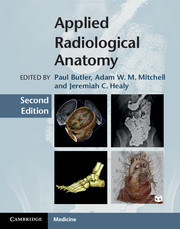Chapter 15 - The upper limb
from Section 3 - Upper and Lower Limb
Published online by Cambridge University Press: 05 November 2012
Summary
Plain radiography/fluoroscopy
Plain radiography demonstrates osseous anatomy and provides some detail of the soft tissue anatomy. Fluoroscopy allows real-time dynamic radiographic assessment of the osseous anatomy and assessment of the joints using fluoroscopic arthrography.
Cross-sectional imaging
CT
Multi-slice CT provides more information about the osseous anatomy than plain radiography, showing the trabecular anatomy of the bone in much higher detail. High-resolution 3D reconstructions of the upper limb allow interrogation in any desired plane. Soft tissues including muscles, tendons and joints can also be identified but these are best assessed with ultrasound and MR imaging.
Sonography
Sonography allows high spatial resolution and dynamic imaging of the soft tissues not obscured by osseous structures. It is particularly optimal for visualization of small and superficial structures (ligaments, tendons) as well as muscle compartments.
MRI
MR imaging offers high contrast resolution imaging of the musculoskeletal anatomy. Intra-articular structures are best assessed using MR arthrography.
- Type
- Chapter
- Information
- Applied Radiological Anatomy , pp. 278 - 318Publisher: Cambridge University PressPrint publication year: 2012

